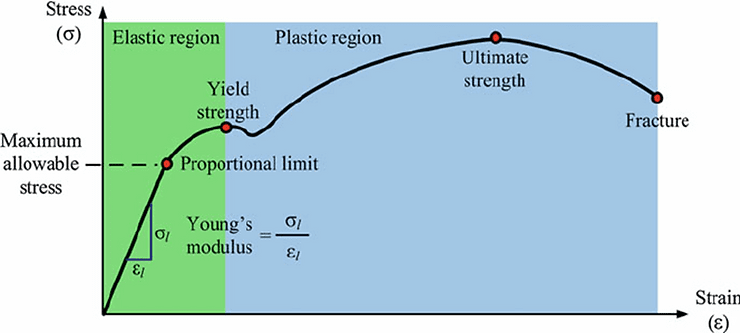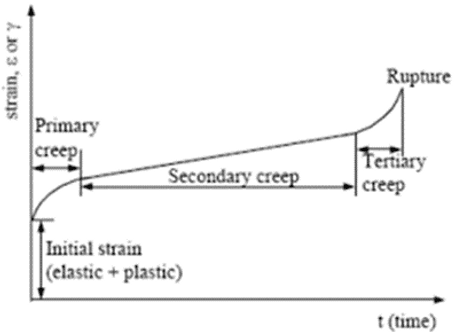What is Mechanical Testing of Engineering Materials?
This article will investigate the various ways in which mechanical testing techniques can be applied to engineering materials. We will examine the equipment and procedure for the mechanical tests and analyse a typical set of results from the test to determine what this tells us about the engineering material properties.
Tensile Test
A tensile test is carried out on a sample engineering material to determine the maximum tensile strength of the material and its elongation at fracture (or failure). This is a common test for materials and perhaps one of the most useful testing techniques. A specimen will be deformed under tension (a ‘pull’ force), usually until the fracture point.
The testing method requires the use of a tensile testing machine equipped with an extensometer and a material specimen. The specimen consists of a material with known dimensions such as the gauge length and diameter, which will give us the cross-sectional area, and is shown in figure 1. Once the material is in place a gradually increasing force is applied uniaxially in the longitudinal direction via the moving cross head. The specimen is elongated at a constant rate during the test where the applied instantaneous load is measured by the load cell and the elongation is measured by the extensometer. The output of the test is recorded on a chart with the load applied versus the elongation of the material.

Figure 1 – Tensile testing equipment
The method is known as destructive testing as the test specimen is permanently deformed and often fractured after the test. The resulting graph that is plotted is usually converted to the engineering stress versus the engineering strain using the original dimensions of the material. The stress and the strain can be found with the following formulas:

Where;
σ = stress (Pa)
F = Force applied (N)
A = Specimen cross sectional area (
ε = strain (no units)
x = material extension (m)
L = Original specimen length (m)
The resulting graph will look similar to that in figure 2 where the elastic and plastic regions can be identified. The elastic region represents the maximum stress that can be applied before the material permanently deforms.
Young’s Modulus
Another key feature from the graph is the Young’s modulus, E. This can be found from the gradient of the straight line, up until the proportional limit is reached. A material with high Young’s modulus requires a higher force to produce a deformation and is more rigid.
The Young’s (or Elastic) Modulus, E, is given by:
E=σ/ε

Figure 2 – Stress strain graph from tensile test
Toughness
Another key feature of a stress strain curve relates to the area under the curve, which can be related to the toughness of the material. Figure 3 shows how example tests for ceramics, metals and unreinforced polymers may look like. As can be seen metals have the expected highest toughness values compared to the smallest in polymers meaning.

Figure 3 – Tensile test for different materials
Example Calculation for Young’s Modulus
Calculate the Young’s modulus from the stress strain graph obtained from a tensile test below. Research Young’s modulus values online and suggest a material that was used in the tensile test.

Solution:
Using values within the proportional limit on the graph the stress reaches a value of 450MPa, and the strain is 0.03 at this stress. The gradient of the line, or the Young’s modulus is therefore:

Material Young’s modulus (GPa)

From the table above, oak or pine wood looks like the closest match to the material involved in the tensile test.
Compression Test
Compression tests are useful for situations where the materials primary loading state will be in compression. The test is similar in nature to the tensile test except that the force applied is compressive (a ”push’ force). Little additional information can be determined from these tests than that already gained from the tensile test.

Figure 4 – Stress compression diagram
Hardness Testing Methods
Another key material property is hardness, this can be thought of as measurement of a material’s resistance to localised plastic deformation. The techniques consist of a small indenter being forced into the surface of the material to be tested. The load and rate of application is controlled. The depth of the resulting indentation is then measured which corresponds to a hardness number. A higher hardness number for a material result in a smaller and shallower depth of penetration.
Hardness tests are performed frequently because they are relatively easy to conduct as they are relatively simple and inexpensive. Figure 5 demonstrates 3 different hardness tests and as stated previously they are all similar in nature with the primary difference being the shape of the indenter. For each of the specimens and hardness tests to collect accurate data specimen depth must be at least ten times that of the expected indentation test depth. The test must be applied at least three indentation diameters away from an edge of the material or the centre of a previous indentation.
The hardness, HV, can be calculated from:

Where;
P is the load in N,
a is the face angle on the diamond,
d is the mean length of d1 and d2.

Rockwell hardness can be found from:

Where;
d is the depth,
N and s are determined from scale factors depending on the test.

Figure 5 – Hardness test and hardness scales
Impact Testing
Impact testing is a way of determining how tough a material is. The area beneath the stress strain curve indicates the materials toughness under gradual loading conditions, however, in the context of an impact test we are looking at notch toughness, a measure of the metal’s resistance to brittle or fast fracture in the presence of a flaw or notch and fast loading conditions.
The type of impact test we will examine is known as the Charpy test. It involves striking a standard specimen with a controlled weight pendulum, travelling at a set speed.
The amount of energy absorbed in fracturing the test piece is measured and this gives an indication of the notch toughness of the test material. These tests show that metals can be classified as being either ‘brittle’ or ‘ductile’. A brittle metal will absorb a small amount of energy when impact tested, a tough ductile metal a large amount of energy. The results obtained from these tests do not allow an exact toughness value to be calculated and are qualitative in nature.

Figure 6 – Charpy test
The Charpy test can be conducted over a range of temperatures to show how temperature affects the mode of fracture. For one type of material a curve is generated and passes through a transition temperature where the failure mode changes from brittle fracture to ductile fracture. Knowing the temperature at which the fracture behaviour changes is therefore of crucial importance when the service temperature of a structure is considered, ideally in service a structure should operate at upper shelf temperatures.


Figure 7 – Charpy curve and fracture modes
Creep Testing
Creep consists of subjecting a material to a constant load or stress whilst maintaining temperature. Deformation is measured and plotted against time and most tests are performed under a constant load.
Creep occurs in three stages: Primary, Secondary, and Tertiary. Primary creep occurs at the beginning of the tests, and creep is mostly transient. Resistance to creep increases until the secondary stage is reached. In this stage the rate of creep becomes roughly steady. In tertiary creep, the creep rate begins to accelerate as the cross-sectional area of the specimen decreases due to necking or internal voiding decreases the effective area of the specimen. If stage tertiary creep is allowed to proceed, fracture will occur.


Figure 8 – Creep test and creep curve
Fatigue Testing
A fatigue test helps determine a material’s ability to withstand cyclic fatigue loading conditions. By design, a material is selected to meet or exceed service loads that are anticipated in fatigue testing applications. Cyclic fatigue tests produce repeated loading and unloading in tension, compression, bending, torsion, or combinations of these stresses. Fatigue tests are commonly loaded in tension – tension, compression – compression and tension into compression and reverse.
The results we can obtain for fatigue testing are highly useful. The lifespan of a material that is put under cyclic loading can be obtained. A fatigue test is also used for the determination of the maximum load that a sample can withstand for a specified number of cycles. The crack resistance of a material can also be found using this testing procedure.
There are many examples of material failure in the past due to not fully understanding the implications of fatigue. For instance, in the aerospace industry it is important to recognise the cyclical loading that a fuselage undergoes every time it is pressurised and de-pressurised with every flight. Similarly, the aircraft wings are cyclically loaded every time they take the weight of the aircraft and then release it at landing.
Online Engineering Courses and Qualifications
Are you interested in learning more about engineering materials?
Do you want to earn an accredited diploma qualification in engineering?
Check out our range of fully accredited online engineering courses and diplomas to gain a formally recognised engineering qualification.
Why not check out the online engineering short courses specifically in manufacturing engineering:
Recent Posts
Understanding and Calculating Generator Efficiency and Output Parameters
Understanding and Calculating Generator Efficiency and Output Parameters Introduction The performance of a generator is often judged by how efficiently it converts mechanical energy into electrical energy. Understanding and calculating this efficiency, along with other key output parameters such as voltage, current, power factor, and load, is essential for evaluating performance and ensuring reliable operation. […]
Essential Cooling and Protection Devices: How They Work and Why They Matter
Essential Cooling and Protection Devices: How They Work and Why They Matter Introduction Generators produce a significant amount of heat and electrical stress during operation, which can affect performance and lifespan if not properly managed. That’s where cooling and protection devices come in. These essential systems, including fans, radiators, circuit breakers, and relays, work together […]
Justifying the Choice of Generators Based on Requirements and Characteristics
Justifying the Choice of Generators Based on Requirements and Characteristics Introduction Selecting the right generator isn’t just about power output, it’s about finding a machine that meets specific operational needs, efficiency goals, and environmental conditions. Different applications demand different generator types, capacities, and features. In this article, we’ll explore how to justify the choice of […]

